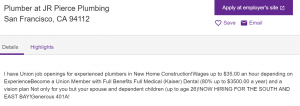The age problem in the plumbing and other blue-collar trades is steadily getting worse. The average age is 49 years old across the entire trades industry. Plumbers, in particular, tend to be older than other tradesmen as well. In Texas, the average plumber is 58 years old and quickly nearing the minimum retirement threshold to start collecting Social Security benefits.
This is not a new crisis, but one the skilled labor industry has seen coming for several decades. It’s also a global problem. A recent survey found that 45 percent of employers worldwide cannot find laborers with the right skills. In the US, this amounts to tens of thousands of jobs left unfilled in skilled trades like plumbing, welding, construction, and more.
There may be some hope on the horizon, however. Skilled labor has a large number of advocates thinking up unique ways to attract workers back to the trade industry. Still, numerous roadblocks remain that make it increasingly difficult to attract young workers toward blue-collar jobs.
Why Are Young Workers Rejecting Plumbing and Other Trades?
There was a time when skilled labor had no problem attracting young workers. Now, however, few young adults look to blue-collar trades as a viable career path. Instead, most high school graduates are heading straight to college, seeking professional services and STEM degrees that offer more the promise of more money and prestige.
In 2016, 69 percent of high school graduates enrolled in college. In 1993, that number was less close to 60 percent. In 1980, just under 50 percent of high school graduates went on to college. NPR also notes that trade jobs are rapidly sitting empty as the number of students opting for college over trades has increased in the past 20 years.
Meanwhile, even as far back as 2004, only 4 percent of high school graduates were pursuing jobs in technical fields. This means that many students who did not go on to attend 4-year institution simply had no interesting in skilled labor. Little has changed since then, and the problem is only compounded by the fact that the current field of blue-collar workers is starting to near retirement.
Interestingly enough, few college graduates actually get jobs in their degree fields. Over 40 percent of college graduates are underemployed after graduation, in fact, while nearly 30 percent are still underemployed even 5 years after graduating from college. This is happening even as the average cost to attend a 4-year college has more than doubled
since the 1980s. College graduates now average over $25,000 – $32,000 in student loan debt.
So why are high school graduates so strongly gravitating toward college over trades?
● Many public and private schools are still pushing the narrative that college is for everyone
● Students are being pushed toward STEM careers that require a college degree to obtain
● Most students are given little to no information about alternatives to a 4-year degree
● Skilled labor has fallen behind in lifetime earnings and salary on the higher end of the labor market
● Most high school graduates now prefer jobs that require little or no manual labor
It’s difficult for the labor industry to contend with most of these on-going issues. In many locations, blue-collar industry leaders have no access to students to provide alternative information on post-high school opportunities.
Although some public schools pay cursory lip service to skilled labor, the reality in most schools is very different. Few promote skilled labor as a respectable alternative to college and offer scant resources to students who may be interested in pursuing those options.
Major earnings differences still exist
The labor market’s earnings gap is also a notable problem to contend with. The average journeyman plumber in California earns just over $28 per hour or under $60,000 per year. By comparison, the average software engineer in California earns over $117,000 per year.
As schools spend more time emphasizes science, technology, engineering and math degrees and careers (STEM) where earnings are notably higher, it’s easy to see why many graduating high school students are also increasingly looking down on trade careers.
How Can The Trade Industry Attract New Workers?
With so many trade workers starting to age out of the industry, creative new approaches are emerging to help attract new workers. With some help from politicians and public figures, blue-collar jobs like plumbing can draw in new workers who might otherwise have avoided trade jobs.
High-profile advocates
One key method the trade industry is using to attract workers is to employ and work with well-known actors, politicians and others who are willing to speak publicly on the importance of trade work.
For example, TV personality and actor Mike Rowe (of Dirty Jobs fame) has made it his mission to highlight the importance of skilled labor and the growing problem with the skilled labor shortage. Since 2008, the mikeroweWORKS Foundation has raised over $15 million to provide scholarships to students interested in learning trades and entering the industry.
Increasing wages
The trade industry has made headway in highlighting a simple concept in economics: supply and demand. As the demand for labor increases while the supply decreases, trade industry jobs have been forced to increase the amount they pay workers. This is a boon for marketing trade industry jobs.
Some technical trade employers are emphasizing their fast-rising and high salaries for even new employees. Many are also comparing their rising salaries to that of white-collar jobs, where some trades can earn more than the average college graduate with a bachelor’s degree.
For example, a recent Bloomberg report found that the average US income was $52,000, while the average salary for a plumber was $58,000. Other trade jobs boasted even higher average salaries, such as power line installers ($70,000 per year), aircraft mechanics ($65,000 per year), and electricians ($59,000 per year).
The New York Times also explained that the top 10 percent of plumbers were earning over $84,000 per year, an amount that will continue to grow as the labor shortage gets larger. Trades are more aggressively marketing these high salaries to draw in potential workers.
To note, these numbers are real. According available data:
● Those with less than a high school diploma average $26,000 per year
● Those with a high school diploma average $35,000 per year
● Those with Associates degrees average $42,000 per year
● Those with a Bachelor’s degree average $59,000 per year
The trade industry can find value in comparing average salaries to those with a Bachelor’s degree, and combine that information with the differences in how much debt college graduates tend to carry.
More benefits for blue-collar workers
Companies are also attempting to draw in new trade workers with a focus on more benefits. This includes paid leave and vacation time and expanded healthcare coverage. Many job advertisements emphasize these benefits alongside higher potential wages.
[Source: https://www.monster.com/jobs/q-plumber-jobs-l-california?jobid=1647546a-a53d-46c7-90dd-492d3397fcf3]
Better training opportunities, including apprenticeships
In 2017, President Trump signed an executive order to expand apprenticeships in the US. As noted in the executive order:
“Apprenticeships provide paid, relevant workplace experiences and opportunities to develop skills that employers value. Additionally, they provide affordable paths to good jobs and, ultimately, careers.”
Many states are also investing more in trade education and apprenticeships, including California. The California Apprenticeship Initiative plans to have 500,000 “earn-and-learn” apprenticeships in place by 2029. Nationwide, more money and attention is going toward supporting an easier, less-costly alternative to college.
This is a big sticking point for the trade industry, as it offers a strong reason for some students to forgo incurring college debt, and instead enter trades where education is fully paid for.
Faster promotion
An interesting approach some companies may want to use is to make promotions not only easier, but different. Redesigning the career path within a company not only offers trade workers more incentive versus white-collar careers but the chance for higher earnings for skilled performance.
A recent Gallup report notes that much of the retention problem that exists within skilled labor is directly related to issues with management and promotion. “Stop making management positions a reward for exceptionally skilled labor,” the report states.
According to the report:
“When companies promote a worker to management on the basis of prior performance, they lose a job expert and obtain a manager who often times has no talent for people management. That’s how moving a single person can create a double negative — and it hurts the business.
A better plan is a redesign of the company’s career path and promotion system.
Allowing job role experts to advance inside their roles keeps great workers doing their great work and keeps management in the hands of people with the ability to do it well.”
This solution may help the skilled labor industry attract new workers in the long run, as the promise of both better pay and promotion opportunities may lead to better outcomes.
The Trade Shortage Will Persist
Unfortunately for the trade industry, a tight labor market makes it more difficult to attract more trade workers. In a good economy where workers are hard to find, trade industries can suffer significantly as more attractive white-collar employers are also raising salaries and offering benefits that are effectively impossible for blue-collar jobs to provide.
Even still, there are thousands of young workers still looking for jobs, and many under-employed college graduates looking to change careers. Plumbing and other trades may still be able to pull in new workers with effective marketing and an emphasis on how much easier and lucrative it is to transition to trade work.
Plumbers and other trade industry employers have unique challenges, including insurance needs uncommon in most other industries. There are even some risks directly associated with hiring workers in a tight labor market. Give us a call at 650-873-1255 and let us walk you through both the common and uncommon risks, as well as how easy it is to protect yourself and your business.



